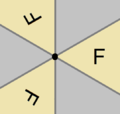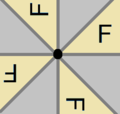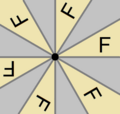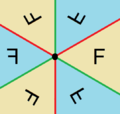Square
[4,4],      IUC
(Orb.)
Geo | Coxeter | Domain
Conway name |
|---|
p1
(°)
p1 | | 
Monotropic | p2
(2222)
p2 | [4,1+,4]+
    
[1+,4,4,1+]+
     | 
Ditropic | pgg
(22×)
pg2g | [4+,4+]
     | 
Diglide | pmm
(*2222)
p2 | [4,1+,4]
    
[1+,4,4,1+]
     | 
Discopic | cmm
(2*22)
c2 | [(4,4,2+)]
    | 
Dirhombic | p4
(442)
p4 | [4,4]+
     | 
Tetratropic | p4g
(4*2)
pg4 | [4+,4]
     | 
Tetragyro | p4m
(*442)
p4 | [4,4]
     | 
Tetrascopic | | Rectangular
[∞h,2,∞v],        IUC
(Orb.)
Geo | Coxeter | Domain
Conway name |
|---|
p1
(°)
p1 | [∞+,2,∞+]
     | 
Monotropic | p2
(2222)
p2 | [∞,2,∞]+
       | 
Ditropic | pg(h)
(××)
pg1
| h: [∞+,(2,∞)+]
       | 
Monoglide | pg(v)
(××)
pg1 | v: [(∞,2)+,∞+]
       | 
Monoglide | pgm
(22*)
pg2 | h: [(∞,2)+,∞]
       | 
Digyro | pmg
(22*)
pg2 | v: [∞,(2,∞)+]
       | 
Digyro | pm(h)
(**)
p1 | h: [∞+,2,∞]
       | 
Monoscopic | pm(v)
(**)
p1 | v: [∞,2,∞+]
       | 
Monoscopic | pmm
(*2222)
p2 | [∞,2,∞]
       | 
Discopic | | Rhombic
[∞h,2+,∞v],        IUC
(Orb.)
Geo | Coxeter | Domain
Conway name |
|---|
p1
(°)
p1 | [∞+,2+,∞+]
       | 
Monotropic | p2
(2222)
p2 | [∞,2+,∞]+
       | 
Ditropic | cm(h)
(*×)
c1 | h: [∞+,2+,∞]
       | 
Monorhombic | cm(v)
(*×)
c1 | v: [∞,2+,∞+]
       | 
Monorhombic | pgg
(22×)
pg2g | [((∞,2)+)[2]]
     | 
Diglide | cmm
(2*22)
c2 | [∞,2+,∞]
       | 
Dirhombic | | Hexagonal/Triangular
[6,3],      / [3[3]], / [3[3]],    IUC
(Orb.)
Geo | Coxeter | Domain
Conway name |
|---|
p1
(°)
p1 | | 
Monotropic | p2
(2222)
p2 | [6,3]Δ | 
Ditropic | cmm
(2*22)
c2 | [6,3]⅄ | 
Dirhombic | p3
(333)
p3 | [1+,6,3+]
    
[3[3]]+
   | 
Tritropic | p3m1
(*333)
p3 | [1+,6,3]
    
[3[3]]
   | 
Triscopic | p31m
(3*3)
h3 | [6,3+]
     | 
Trigyro | p6
(632)
p6 | [6,3]+
     | 
Hexatropic | p6m
(*632)
p6 | [6,3]
     | 
Hexascopic | |



















































